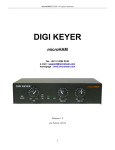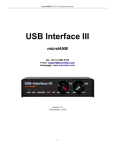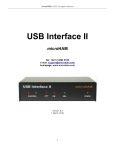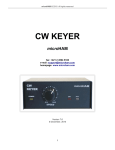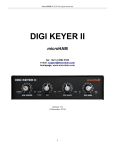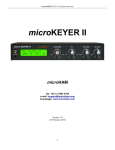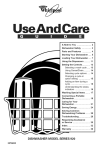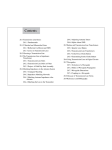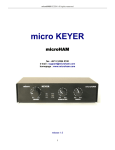Download microHAM Digi Keyer II Specifications
Transcript
microHAM © 2008 All rights reserved DigiKeyer microHAM fax: +421 2 4594 5100 e-mail: [email protected] homepage: www.microham.com Version 7.2 14 July, 2008 1 microHAM © 2008 All rights reserved TABLE OF CONTENTS CHAPTER PAGE 1. FEATURES AND FUNCTIONS ................................................................................................... 3 2. IMPORTANT WARNINGS .......................................................................................................... 3 3. PANEL DESCRIPTION ............................................................................................................... 4 Front Panel ......................................................................................................................... 4 Rear Panel .......................................................................................................................... 5 4. INSTALLATION .......................................................................................................................... 6 Preparing for Use................................................................................................................. 6 Installing microHAM USB Device Router ..............................................................................7 Configuring USB Audio Codec .............................................................................................8 Configuring microHAM USB Device Router ....................................................................... 9 Creating and Using Virtual Ports ....................................................................................... 10 5. microHAM DEVICE ROUTER .................................................................................................. 11 Menu: Router .................................................................................................................... 11 Menu: Preset ..................................................................................................................... 12 Menu: Device .................................................................................................................... 13 Menu: Virtual Port ............................................................................................................. 14 Menu: Help ........................................................................................................................ 15 Device Configuration ......................................................................................................... 15 Ports Tab........................................................................................................................... 16 CAT& 2nd CAT ............................................................................................................. 17 FSK & 2nd FSK ........................................................................................................... 19 CW .............................................................................................................................. 20 PTT & 2nd PTT ........................................................................................................... 21 Squelch ....................................................................................................................... 21 Control..........................................................................................................................21 Keying Tab......................................................................................................................... 22 Audio ........................................................................................................................... 22 PTT...............................................................................................................................23 FSK from Keyboard .....................................................................................................23 FSK Messages ...................................................................................................................24 6. EXTERNAL KEYBOARD .......................................................................................................... 25 7. PACKAGE CONTENTS ............................................................................................................ 25 8. WARRANTY .............................................................................................................................. 26 9. SPECIFICATIONS .................................................................................................................... 26 System Considerations ..................................................................................................... 27 Hardware Specifications .................................................................................................... 27 APPENDIX A – CONNECTORS .............................................................................................. 28 APPENDIX B – APPLE OS 10 INSTALLATION ....................................................................... 29 APPENDIX C – RFI Considerations ......................................................................................... 30 Declaration of Conformity ........................................................................................................ 31 2 microHAM © 2008 All rights reserved 1 - FEATURES AND FUNCTIONS No Serial or Parallel port necessary, just one USB port Complete "Computer <-> Radio" isolation • bidirectional transformer isolation of audio signals • optical isolation of ALL digital signals: Radio Control, CW, PTT, FSK Internal USB sound capability • Wide range audio level: works with transceiver levels from 100 mV to 1.5 V • Extremely low noise floor: as low as 0.7 mV effective • High dynamic range: 84 dB typical, 82 dB minimum Compatible with all MS Windows based logging or control software • the special microHAM "USB Device Router" program creates virtual COM ports for full operation with standard Windows applications. • customizable presets allow instantly changing DIGI KEYER parameters to match the program currently in use Integrated computer control port for all radios CI-V, FIF-232, IF-232, RS-232 • fully supports Icom, Kenwood, TenTec, Yaesu and other radios • no separate level converter required Squelch input for additional software control Strong RFI immunity • integrated chokes and filters for best RFI immunity • advanced shielding and circuit design for RFI product suppression Connections: • Computer – USB • Radio - DB15 Front panel LEDs for easy visual feedback of CW, PTT, SQL, POWER and radio control data Front panel adjustable Transmit and Receive audio levels USB sound support built-in to the Operating System • does not require special drivers or limit your choice of applications. • Supported under Windows, Apple OS 10 and LINUX Metal/Aluminum case, powder coated and silk screened Free, no time limit, on-line firmware/software upgrades 2 - IMPORTANT WARNINGS You must set the CAT level jumpers inside the DIGI KEYER before using it for the first time. If you power DigiKeyer from an external power supply ALWAYS check the polarity of the external 13.8 V supply. If your radio includes upgradeable firmware, DO NOT perform any upgrade through DigiKeyer. 3 microHAM © 2008 All rights reserved 3 - PANEL DESCRIPTION FRONT PANEL (1) – POWER YELLOW color indicates when unit is powered (2) – TX Adjusts transmit audio level (drive) (3) – CW/FSK RED color indicates when CW is active, GREEN indicates when FSK is active (4) – SQL GREEN color indicates when squelch is active (5) – PTT RED color indicates when PTT is active (6) – RX #2 Adjusts receive audio level from the second (sub-, aux-, etc.) receive channel. (7) – RX #1 Adjusts receive audio level from the main receive channel. 4 microHAM © 2008 All rights reserved REAR PANEL All connectors for connecting the computer, radio and accessories are located on the rear panel. (1) – PA PTT: PTT output for Power Amplifier Ground during transmit TIP - Signal SHELL - Ground (2) - LNA PTT: Control output for Low Noise Amplifier Ground during transmit TIP - Signal SHELL - Ground If the jumper is in SS position, open collector switching transistor is connected to the PAPTT or LNAPTT output jack. The transistor can switch up to 48V @ .8A. This position is appropriate for modern Power Amplifiers with electronic keying and LNA bypass relays . Check manual of your PA and LNA to be sure the power requirements do not exceed the transistor rating otherwise set the appropriate jumper to the RE position. This position connects the relay contact to the output jack. Maximum rating for the relay is:48V AC/DC @ 1A. NOTE: If you are not sure about keying voltage of your amp on LNA, use the RE position. (3) - RADIO: DB15F connector for radio interconnection – a detailed description is in Appendix A (4) - REM: MiniDIN6 for PS/2 keyboard or numeric keypad. (5) - USB: USB B connector for computer connection. Connect the supplied USB A-B cable. 5 microHAM © 2008 All rights reserved 4 - INSTALLATION Installing DIGI KEYER consists of several steps: 1) prepare DIGI KEYER to work with your radio 2) install microHAM USB Device Router (the control and interface software) 3) configure the Windows USB Audio Device 4) configure Router Preparing DigiKeyer for Use 1. Remove the top cover from the DIGI KEYER and set the CAT jumpers as shown in the following chart. The CAT interface jumpers must be configured to select the proper level for each radio type. RS-232 levels: Elecraft: K2, K3, Icom: 7800, JRC: JST-245, Kenwood TS-480, 570, 870, 2000, TenTec: all radios with DB9 or DB25 connectors Yaesu: FT-450, FT-847, FT-920, FT-950, FT-1000MP, Mark V, Mark V Field, FT-2000, FT-9000 RS232 IF-232 levels: Kenwood: TS-140, 440, 450, 680, 690, 711, 790, 811, 850, 940, 950 IF232 FIF-232 levels: Yaesu FT-100, 736, 747, 757GXII, 767, 817, 840, 857, 890, 897, 900, 980, 990, 1000, 1000D FIF232 CI-V levels: Icom: all radios except 7800 with RS-232 TenTec: all radios with 3.2 mm connector CI-V NOTE: the CAT interface is not configured at the factory. 2. Plug the DB15M on the radio cable set into the DB15 connector on the rear panel of the DIGI KEYER and plug ALL connectors from the cable set to the appropriate jacks at the rear panel of your transceiver. Each connector on the radio interface cable is marked same as the matching jack on your transceiver. 3. If the radio cable ends with leads for external power, connect these leads to a 12-16V DC power supply. Be sure to observe the proper polarity. 4. Locate but do not connect the USB cable from DigiKeyer to your computer. 6 microHAM © 2008 All rights reserved Installing microHAM USB Device Router To install Router click on the Install USB Device Router link on the installation CD or download the most recent installation package from the web site: www.microHAM.com/downloads.html. If you download an updated package, click on "urouter_release_xx_xx.exe" (xx_xx is version) to start the installation. The Windows setup utility will start and ask into which folder Router and its supporting files should be installed. Note: unless you have a very strong reason to install Router elsewhere, please accept the default location. When the Router installation is completed, click "Finish" to launch Router for the first time. Then plug in the USB cable and proceed to configure Router for your station and software. 7 microHAM © 2008 All rights reserved Configuring USB Audio CODEC Windows will automatically install the USB Audio Device driver to support the USB Audio CODEC in DIGI KEYER. Windows automatically selects any newly installed audio device as the default device for Sound Playback and Sound recording. This is undesirable as Windows Sounds would be played through DIGI KEYER and onto the air! In Windows 2000 and Windows XP, open "Sounds and Audio Devices" in the Control Panel or right click on the Speaker icon on the Taskbar and select Adjust Audio Properties. Reset the Default device for Sound Playback and Sound Recording to your computer's primary sound device. In Windows Vista, open "Sound" in the Control Panel or right click on the Speaker Icon on the Taskbar and select "Playback Devices." Reset the default to the Speakers of your compuer's primary sound device. 8 microHAM © 2008 All rights reserved Configuring microHAM USB Device Router The MicroHAM USB Device Router (Router) program provides a Windows compatible configuration tool for microHAM USB Devices (DIGI KEYER as well as microKEYER, CW Keyer and USB Interfaces) and software interface to other Windows applications (loggers, digital mode software, etc.). The software interface is provided as Virtual Serial Ports. To configure and use DIGI KEYER with Windows compatible application programs it is necessary to have installed the USB driver, started the Router, and applied power to DIGI KEYER by turning on the attached radio or external power supply. Router is then configured to match the requirements of the application (logger or digital mode) software. DIGI KEYER Status When the USB driver is installed correctly and DIGI KEYER is powered from a radio or external 12V DC supply Router will show a device tab with a GREEN check beside the device name (DIGI KEYERI). When Router shows a YELLOW “X” instead of a green , it means the USB driver is correctly installed but DIGI KEYER is not receiving power from the radio or external supply. When Router shows a RED “X” insted of a green , it means the device is disconnected and Router does not see the USB part of DIGI KEYER. This happens when the USB cable is unplugged or the USB driver is not correctly installed. Initial Setup Router must be used to configure DIGI KEYER for proper operation. The device configuration tab (in the red rectangle) is used to setup each part of the DIGI KEYER – virtual ports for communicating with the application (Ports), audio levels, PTT and keyboard FSK (Keying), and stored FSK messages (FSK Messages). 9 microHAM © 2008 All rights reserved Creating and Using Virtual Serial Ports microHAM Router provides a set of virtual serial ports which allow Windows applications (loggers and digital software) to work with DIGI KEYER just as they would work with "real" (hardware) serial ports. In order to use these virtual Ports, you must first create the ports and then assign a function (radio control, PTT, CW, FSK, etc.) to each virtual port. DO NOT define a port that is already in use (for example, COM1 or COM2 which are hardware ports on many motherboards) or a virtual port used by another USB device. Even though Router will not allow using a COM port number which is already present in the system (like hardware COM ports or internal modems), sometimes these ports are hidden. If a device which also uses virtual serial ports (external USB devices, bluetooth devices, mobile phones, PDA etc ...) is not connected to the computer when creating virtual ports in Router, the ports can overlap and will not work properly when you connect such device. IMPORTANT WARNING: Before you start creating virtual COM ports, attach all external devices you use with the computer and allow them to connect to the system. Restart Router and then create the virtual COM ports. Virtual ports are created from the Virtual Port menu. Create - Creates virtual COM ports. It is possible to select more than one port at a time by holding the Ctrl key on keyboard and clicking on COM port numbers. Creating virtual ports may take a long time (several tens of seconds), be patient. Delete - Deletes any single virtual port. Delete All - Deletes all previously created virtual ports. Do not delete a virtual port until all applications using that port have been closed. TIP: It is possible to select multiple ports at one time by holding Control key on keyboard and clicking on the COM port numbers. TIP: If you have uninstalled another device which used virtual ports and Router does not offer the released COM port number, you will need to reset the virtual port bus. You can do this by deleting all the virtual ports at once. Select "Virtual Port | Delete All" and create the ports again. Any missing port number should appear. 10 microHAM © 2008 All rights reserved 5. microHAM USB DEVICE ROUTER ROUTER MENU Restore Router Settings: used to restore settings from a urs file created by the backup command. A urs file can be used only with the device for which it was generated (the file contains the unit serial number) on a computer with same port assignments. WARNING: Restoring a backup replaces all current Router settings including presets, use it carefully! Backup Router Settings: used to create backup urs file. This file contains Router settings (including Presets) for all devices defined in Router. Options | General - Load Router on Start-up: when checked, Router will start automatically each time the computer is started or rebooted. - Start Router Minimized: when checked, Router will started minimized Options | Band Map: - Does not apply to DigiKeyer Customizable band edge boundaries used to drive the band data output. BCD codes can be customized for driving antenna switches or bandpass filter control. Options | Digital Band Map: - Does not apply to DigiKeyer Customizable band boundaries for the digital mode operation. These settings are used for the (optional) automatic selection of audio switching and PTT mode based on operating frequency. Careful selection of the "Digital band" is neccessary for transceivers which do not have a special mode for AFSK operation or do not report the mode in the computer command set. This primarily effects Kenwood and TenTec transceivers although it applies to some older Icom and Yaesu radios. Options | Audio Devices: - Don't use audio devices: when checked, Router does not use audio devices and the settings on the Audio Mixer and DVK tabs have no effect. - Manualy assign audio devices: when checked, Router will allow the user to select audio devices (sound card) in the appropriate fields at Audio Mixer tab and will actively control the audio devices - Automaticaly assign microHAM audio devices: when checked, Router will automatically assign proper audio device of the same name if multiple microHAM interfaces of the same kind are connected to the one computer. Options | DVK: - DVK not supported by DigiKeyer - Voice message time limit: maximum time for each voice message up to 120 seconds. - Sample rate: sampling frequency used during recording and playback of voice messages. - Sample size: sampling size used during recording of voice messages. Sampling size primarily effects audio quality of the messages. 16bit samples provide higher quality than 8bit. Options | USB: - Noise immunity: selects how many times an undelivered USB packet will be repeated before the USB device is disconnected from the operating system. - Response time: selects how long the USB chip in a device will wait for additional data before sending data to the operating system. 11 microHAM © 2008 All rights reserved Minimize: Clicking this will minimize Router to the system tray at the bottom right corner of the Windows Taskbar (the "System Notification Area"). TIP: When Router is minimized you can restore it by double-clicking on the Router tray icon. You can also restore Router by double-clicking on the Router icon on the desktop or restarting Router from the Programs menu. Exit: Clicking on this item will terminate Router. NOTE: when Router is terminated, application software will be unable to communicate with DigiKeyer and the radio. PRESET MENU The requirements of each program are different and each one may handle radio control, CW and PTT in its own way. In some cases what works for one application may not work properly with another. To get maximum performance from CW Keyer, you may wish to customise the settings for each application. For easy switching among applications, Router supports up to 12 user definable Presets. Different configurations can be stored in these presets and recalled almost instantly simply by clicking on the preset button. Each preset contains the settings for all devices connected to, and controlled by, Router. For example, if Router controls a microKEYER, a DigiKEYER and a USB Interface, each preset remembers the settings for all devices including the assignment of COM ports and the contents of all sub-tabs except the FSK/CW Messages and DVK tabs. NOTE: Presets for various loggers are not available until they have been saved by the user using Preset | Save as. For setup instructions for various loggers refer to Setup Guide documents available in Router Help menu (Use Help | Download Documents first if Help | Setup Guides are not available or incomplete). There are three ways to apply a preset once it is created: 1. Click on Preset and select the desired preset from the pulldown menu. 2. Click on a preset button. To have buttons visible in Router, Preset | Show Buttons must be checked. When the settings from a preset are applied, a green light located in the preset button is lit. This green light is on ONLY when all settings in Router are same as those stored in the preset. 12 microHAM © 2008 All rights reserved 3. By right clicking on the system tray icon when the Router is minimized. The presets and the current router configuration are stored to the registry when Router is closed and recalled when Router is loaded. Save as - Saves the current Router settings to a preset for future use. Rename - Allows renaming of an existing preset. Delete - Delete chosen preset. Show buttons - When checked, Router shows the preset buttons. DEVICE MENU Router can control several devices. This allows configuring the settings for all connected devices at one time by using the Presets. Each device has its own tab (page) in the main Router notebook. The content of a device tab depends on device type. Adding a device is automatic the first time Router detects a supported device (USB driver). Once detected, a device remains in Router even though device is disconnected. Each device is identified by product identification number and a unique serial string. Rename – Creates a custom device name. This is useful if two or more devices are connected to the Router. For example CW KEYER, micro Keyer and USB Interface II can be renamed to more identifiable names as shown here.. Delete - Removes a device from the Router. Only disconnected devices with a RED “X” on device tab can be removed. To disconnect a device from Router, unplug the USB cable from the computer or device. Save Template - will save the current Router settings to template file. When clicked, Router will open a standard File Save dialog window – the default location is C:\Documents and Settings\All Users\Application Data\microHAM\cfg. If a hypertext (html) or plain text (txt) documentation file of the same name as the template is present in the same directory, it will be associated with the template. Load Template – will automaticaly configure Router from a template (*.tpl file). When clicked, Router will open a standard File dialog – the default location is: C:\Documents and Settings\All Users\Application Data\microHAM\cfg - and the desired template can be chosen. When Router loads a template, it looks for an html or txt file with the same name as the template in the same directory. If such file is found, it is displayed. 13 microHAM © 2008 All rights reserved TIP: Templates are a powerful tool for quickly configuring Router to work with a particular application. Template files are interchangeable between computers and are well suited for cloning setups when using the same application in multi-computer stations or for sharing custom setups between users. Upload Firmware: microHAM will occasionally release updates to the firmware in DigiKeyer. The update may support news feature in Router or improve application compatibility. The recent public version of the firmware is always available from www.microHAM.com/downloads.html. To update firmware, download the firmware file to your computer, then click on Device | Upload Firmware. A Windows file dialog will open; navigate to the directory into which you downloaded the firmware file and select the file. TIP: When you upgrade Router, the upgrade will include the latest firmware file. The new firmware will be automaticaly uploaded to DigiKeyer when the new version of Router connects for the first time, you have just to allow the upgrade when prompted. VIRTUAL PORT MENU It is necessary to create several virtual serial ports (COM ports) in order for a Windows application (logging, control or digital mode program) to access microHAM devices. Create - Creates virtual COM ports. It is possible to select several ports at one time by holding the Ctrl key on the keyboard and clicking on COM port numbers. Creating a virtual port may take a while, be patient. Delete - Deletes any single virtual port. Delete All - Deletes all previously created virtual ports and resets Virtual Serial Port bus. Do not delete a virtual port unless all applications using that port have been closed. Virtual Serial Ports can be reviewed in Device Manager, under the ELTIMA folder. NOTE: Properly working ports should not display an exclamation mark (!). 14 microHAM © 2008 All rights reserved HELP MENU Manuals: Link to microHAM manuals located on your system Setup Guides: Link to software configuration guides for many common applications. Download Documents: Downloads microHAM documentation including updated manuals and setup guides. You may specify the products for which you want documentation. NOTE: Requires an internet connection. microHAM Home Page: Link to www.microHAM.com microHAM Downloads Page: Link www.microham.com/downloads.html Show Tooltips: When checked, small, single line help is displayed below the mouse cursor Update Router: Download and install the most recent version of Rotuer. About: Shows the Router's internal version number DEVICE CONFIGURATION TABS There are three (3) tabs for configuring DIGI KEYER. Each tab controls a part of DIGI KEYER's functions. Any change to the first two (2) tabs are applied immediately to DIGI KEYER. Changes in Messages are NOT applied automatically. To store them use buttons Store or Store All. Ports - used to assign virtual ports to the DIGI KEYER for use by applications. Keying - used to configure timing of the PTT signal, opertion of the FSK keyboard and the audio processor. Messages – used to store FSK messages. 15 microHAM © 2008 All rights reserved Ports Tab Once the virtual ports have been created they must be associated with a specific device channel (e.g., Control, CW, PTT, etc.). These assignments should correspond to settings of the application software and must be configured first in Router then in the application (e.g., logging program, MMTTY, STREAM, etc.). Proper configuration of the port assigments in this tab is crutical for intergration with loggers. Read the following information carefully. DigiKeyer has nine functions with indication of the state and settings applied by the host application ● ● ● ● ● ● ● ● ● CAT (uses RxD and TxD) 2nd CAT (virtual “fork” for the main CAT channel) FSK (uses TxD and optionally RTS/DTR for PTT) 2nd FSK (uses TxD and optionally RTS/DTR for PTT) CW (uses DTR or RTS) PTT (uses DTR or RTS) 2nd PTT (uses DTR or RTS) Squelch (uses CTS, DCD, DSR or RING) Control (uses RxD and TxD) General note: Do not assign virtual ports to those functions which are not used by the application. It is unnecessary and only consumes resources. 16 microHAM © 2008 All rights reserved CAT PORT & 2nd CAT PORT The CAT channel is used by application software to control transceiver frequency, mode, T/R switching and many other parameters using a serial (CAT) protocol. Most modern radios implement some form of CAT but almost every radio implementation is different. The functionscontrolled by the computer depend on the particular application and radio. NOTE: The port number assigned in Router MUST match the port number assigned in the host application. First configure the virtual COM ports in Router then configure the application. When a COM port is assigned in the Router but not in the aplication (or the application is not running) Router will indicate the channel is closed. When an application opens the COM port assigned for control (usually at start-up), Router shows the channel as open and displays baud rate, data bits, parity and number of stop bits used by the applicaiton. For example, 4800 8N2 means: 4800 baud, 8 bits data length, parity = none, and two stop bits. Data flowing through the CAT channel is indicated by two arrows. A green arrow indicates data flow from the application to the radio and a red arrow indicates data flow from the radio to the application. TIP: If the application provides for PTT (T/R) keying by radio control (CAT) turn this function OFF. PTT by CAT is not reliable because RFI can prevent the radio from switching back to receive. In addition, microKEYER II cannot control an amplifier when the application uses PTT by CAT since it has no way to sense that the the application has placed the transceiver into transmit. There is a dedicated T/R switching channel for this purpose called PTT. NOTE: The virtual COM port does not use handshaking signals. Configure DTR and RTS settings in your application program (logger) to OFF. Do not select “Handshake.” In order for Router to support two CAT ports, it needs to know what transceiver (CAT protocol) is being used so it can direct the transceiver's responses to the proper application. To select the radio, click the Set button. Choose your radio in the Radio combo box. Then select communication speed in the Baud rate box. Note: The baud rate must match your radio. All Icom and some TenTec radios require the correct CI-V address. If everything is configured properly, the current operating frequency and mode should be displayed. TIP: Disable the Autobaud function in any Icom transceiver used with Router. Configure the radio, Router, and your application software to operate at 9600 or 19200 baud. Disable router queries – When this box checked, Router will not poll the radio for frequency and mode when that information is not available from the communication between the application and radio. 17 microHAM © 2008 All rights reserved NOTE: "Disable router queries" disables Router polling only when the port has been opened by an application program. When the virtual port is closed, Router always polls the radio to support the automatic switching functions of microKEYER. If it is necessary to disable all polling, select one of the "none" options in the Radio box. PW1 on radio bus – When this box checked, Router periodically generates an Icom "Transceive" broadcast to keep the PW1 synchronized. The bottom two-thirds of the Radio window is a serial communication monitor. The monitor uses colors and tags to indicate which device is responsible for the data. Black queries (H1-TX or H2-TX) and grey radio responses (H1-RX or H2-TX) are from the "host" application (e.g., logger), H1 indicates the host application on the main CAT port, H2 is the host application on the 2nd CAT port. Green packets (R-TX and R-RX) are polls/responses from/to Router and not routed to the application. Router monitors the communication when the host application performs control and polls the radio periodically for any missing information (VFO frequencies and mode). Because some applications do not poll the radio regularly or completely, Router must break this communication to update its internal state. In order to avoid confusing the application when Router polls the radio, data from the application is buffered and sent to the radio after Router receives a response to its query. If Router does not receive response to a poll within the time allowed or does not understand the response, it displays "oldest query discarded" but forwards all data to the virtual serial port to avoid confusing the application (logger). Since USB transmits data in frames with a delay between frames, Router indicates frame boundaries with three dots (...). When a packet ends with three dots it means that the data continues in the next frame. 2nd CAT PORT Beginning with version 7.0, Router provides unique control capability: the 2nd CAT Port is an intelligent data fork (software 'Y' connector) that allows a second application to share control of the radio. Router monitors when data is sent from each application and routes the radio's responses to the correct virtual port. IMPORTANT: Both applications must use same communication parameters (baud rate, data length, parity and number of stopbits) for proper operation! Neither CAT port has priority. Polls/commands from the applicationa are processed alternately. In order to avoid collisions and confusion due to unexpected data, responses from the radio are returned only to the application that generated the command. Unsolicited data such as automatic frequency/mode updates (Icom "transceive" packets or "Auto-information" data from Kenwood, Elecraft and recent Yaesu transceivers) is forwarded to both CAT ports. Due to physical limitation of data channel throughput and the controller capabilities in various transceivers, there are several important rules which must be observed. ● Combined data from both applications must not exceed maximum throughput of the radio control port and transceiver controller. In other words, the polling rate from one application may need to be decreased to provide data space for the second application and vice versa. ● Applications must be tolerant of delayed responses from the radio. Each application must wait for the radio to respondwhen the another application is communicating with the radio. ● Due to protocol deficiencies in handling VFO split commands with many transceivers (particularly Icom), split mode must be initated and ended by only one application and manual split control (from the front panel of the radio) should not be used. NOTE: Despite extensive testing using various combinations of applicaitons for the CAT and 2nd CAT ports, microHAM cannot guarantee proper operation with every potential combination of applications. 18 microHAM © 2008 All rights reserved FSK & 2nd FSK PORTS The FSK channel is used by the application program to send the FSK keying signal. FSK is used primarily for RTTY. It is very important to understand the difference between FSK and AFSK. FSK is a digital (On/Off) signal from the computer serial port (or an external modem). This signal is used in the transceiver to generate a frequency shift. FSK must be supported by the transceiver (this mode is commonly labeled RTTY or FSK). AFSK is a analog (audio) signal generated by the computer sound card (or external modem) used in the transceiver modulation circuits for operating digital modes as RTTY, PSK31, AMTOR etc. Computer sound card generated AFSK or PSK does not require special transceiver support and can be used in the LSB, USB or FM mode of the transceiver. Some radios have dedicated modes for AFSK (generally labeled PKT or DATA) with special features. It is very important to properly adjust the audio drive level of an AFSK system so as to not overdrive the first transmit audio amplifier stage in the transceiver and produce a wide, distorted signal, full of intermodulation products. It is important to appreciate that distortion generated at this point due to overdrive CANNOT be reduced or eliminated by the reduction of the microphone gain control – it is the signal level that must be adjusted to be about the same as would be expected from a microphone. The microphone gain control then becomes a form of transmit power control. An initial indication of proper audio drive level can be seen on the ALC meter of the radio. Provided that there is NO audio processing in circuit and that the microphone gain control is in its normal operating position, then, if the ALC does not show or just starts to indicate during transmission, the signal is likely to be clean. It is also important is to turn off the microphone compressor, ANY transmit audio equalizer, AND transmit DSP when AFSK is used. DO NOT use any form of digital modulation (sometimes called "Transmit DSP") with AFSK or PSK. Some transceivers bypass these circuits automatically when signal is routed to the rear audio jack instead of the microphone jack, but some do not (for example, the TS-850). Edited by Geoff Anderson, G3NPA If your transceiver supports FSK, use FSK for RTTY whenever possible. It's the only sure way to get a clean RTTY signal no matter the microphone gain or compressor (processor) settings on your radio. When a COM port is assigned in Router but not in the application program (or the application is not running), Router will indicate the channel is closed. When an application opens the COM port, Router will indicate the channel is open and display baud rate, number of data bits, parity and number of stop bits in use. For example, 45 5N1.5 means: 45 Baud, 5 data bits, no parity, 1.5 stop bits. The second FSK port is usefull when operating split with radios that have two receivers (e.g., FT-1000, FT-2000, FT-9000, K3, Orion or IC-7800). The second instance of the RTTY program should specify "right channel" for its audio source and should be configured to use the 2nd FSK port for its FSK output. Radios without a second receiver can use the 2nd FSK port for a second RTTY program with a different decoding algorythm to provide diversity decoding and transmit from either program. TIP: If you see a baud rate other than 45.5 baud (e.g., 4800 or 9600), the application is NOT configured correctly for FSK RTTY operation. PTT: The virtual port used for FSK can also support PTT (required by MMTTY). When you use MMTTY, select the PTT box and RTS will used for PTT. Do not use the FSK port for any other function. 19 microHAM © 2008 All rights reserved Invert: Some transceivers lack the ability to set the sense of the FSK input. If you cannot set the proper sense, check the invert box. This is normally necessary only with the TenTec Omni V, Omni VI and Kenwood TS-940. Strict bps: Some programs rely on the the FSK port for proper PTT timing; they drop PTT (unkey) when the FSK port buffer is empty. With virtual ports, this may cause PTT to drop before the contents of a message (macro) are complete. 'Strict bps' disables the virtual port buffering and transmits one character at a time to the output. Due to the additional overhead, FSK output will be slightly slower but operation will be more reliable. To test FSK operation from the computer to the radio, click on Test button with no port assigned or the port closed. The Test button will generate "RY" two times. CW PORT By its very nature, USB is not well suited to transfer the real time events required for CW keying. In addition to the latency inherent in the USB protocol, delays due to CPU load, internal Windows message processing (inter-process communication) and data flow from another peripherals sharing same the USB root hub can result in transmitted characters that are garbled. To minimize these unwanted operating system effects Router uses a specially developed oversampling and prediction algorithm to assure the smoothest possible transfer of control signal events over USB. Using these techniques, CW keying in the Router is, in most cases, usable up to 50 WPM if the application generates keying signals accurately and does not consume 100% of CPU time at the highest priority class. Router allows assigning a virtual serial port for software CW using DTR or RTS signals. The DTR* and RTS* are identical to DTR/RTS except that the output is inhibited for one second after the COM port is opened. RTS*/DTR* should only be used with programs that cause unwanted key-ups during startup. TIP: More applications use DTR for CW than RTS. When an application opens the COM port (usually at start-up), Router will indicate the channel is open. The state of the CW channel is indicated by a red arrow. If port is opened, it does not mean that it is properly configured. The red arrow will light in time with the transmitted CW when the port is properly configured. To test CW operation, click on the Test button with no port assigned or the port closed. 20 microHAM © 2008 All rights reserved PTT & 2nd PTT PORTS The PTT channel is used for T/R switching of the transceiver, Power Amplifier and Low Noise Preamplifier (LNA). An internal T/R sequencer assures 100% protection against transmitting through the LNA or hot switching of the PA when the PTT channel is used for T/R switching. More information about T/R switching, DIGI KEYER PTT outputs and the sequencer is provided under the Keying Tab (page 21). Router allows assigning virtual serial ports for PTT using the DTR or RTS signals. DTR* and RTS* are identical to DTR/RTS except that the output is inhibited for one second after the COM port is opened and . should only be used with programs that cause unwanted key-ups during startup. TIP: More applications use RTS for PTT than DTR. The state of the PTT channel is indicated by a green arrow. If the port is opened, it does not mean it is properly configured. When the port is properly configured, the arrow will light during the entire transmission. To test PTT operation, click on the Test button with no port assigned or the port closed. The 2nd PTT channel is identical to the primary PTT channel. 2nd PTT provides a way for a second application to key the radio if the primary application also controls PTT – for example, a logging program and CW reader/keyboard. TIP: Always use serial PTT instead of the radio command PTT or VOX. It is the only way to assure proper sequencing of a Power Amplifier, LNA, or receive antenna switch. To test PTT, click on the Test button with no port assigned or the port closed. SQUELCH PORT Even though most applications do not monitor the squelch and do not have the ability to perform specific functions based on its status, we have decided to include this feature in Router. Perhaps someday applications will be able to detect the squelch and use this information for automated functions like audio recording. Router allows assigning a virtual serial port to squelch as CTS, DSR, DCD or RING. When a COM port is assigned to the squelch channel in Router but not in the application (or no application is running), Router shows the channel as closed. When an application opens the COM port (usually at start-up), Router shows channel as open. When squelch is active, this state is indicated by a red arrow. CONTROL PORT The Control Port allows an application program (logger) that implements the microHAM Control (SO2R) Protocol to use the stored CW messages. This port should normally be set to "none." The Mon button opens a logging window that permits capture of Protocol data between the application and Router for later analysis. The Control monitor operates the same way as the CAT port monitor. The buffer captures the last approximately 20K of data. Do not enable logging unless necessary for debugging purposes as it imposes a minor performance penalty. 21 microHAM © 2008 All rights reserved KEYING TAB The Keying tab includes controls for the USB Audio processor, PTT and FSK Keyboard. Audio Note: Audio controls are not availble under Windows Vista due to operating system limitations. Transmit Level: sets the level of the audio output from the digital to analog converter. Preset the slider between 50 and 80% of full scale. Adjust the drive to your transceiver with the TX pot on the front panel of DigiKeyer. RX sub & RX main: these "stacked LED" displays show the audio level into the analog to digital converter. Adjust the RX #2 and RX #1 pots on the front panel of DIGI KEYER so that the strongest signals only occasionally show RED. Sample Rate: sets the sample rate used for the RX level displays. Note: Sample Rate defaults to OFF. Due to the way Windows handles multiple access to sound cards, it is best to leave the sample rate OFF when not using the RX display to set levels. Generate Test Signal: causes DigiKeyer to output a 1500 Hz audio tone for setting the transmit output level. TX Mixer: this button opens the Windows Volume Control (Playback Mixer) for the selected sound card. GET ID: this button will retrieve the name and number of the sound card used for transmit functions. The name can be used to verify that the correct sound card has been selected. The number can be used to configure software that identifies sound cards only by number. Some tips from Geoff Anderson, G3NPA: TIP: If you have achieved the correct settings for the transmit levels, you will see that changing from the PSK tuning tone to typing text, will make the transmitter power swing from 50% (no typing) to 100% (typing or tuning-tone) as observed on an RMS or average reading meter. This change in power is correct. If you do NOT see this 50% change (or greater), then you are probably overdriving the radio. Please note that some radios have inbuilt power meters which give a PEAK reading and therefore the change in level discussed above will not be observed. TIP: Don't fall into the trap of thinking that because the transmit signal on the waterfall looks good that your actual signal is OK. All the waterfall is showing during transmit is the local audio and NOT the resultant transmitted signal. 22 microHAM © 2008 All rights reserved PTT – T/R KEYING DIGI KEYER has three (3) PTT outputs: PTT, PA PTT and LNA PTT. PTT is brought out to the DB15 Radio connector. PA PTT and LNA PTT are available on RCA connectors at the DIGI KEYER rear panel. PTT is normally wired to the radio Accessory jack and is used to switch the radio into transmit. PA PTT is present at the DIGI KEYER rear panel RCA jack and is designed for switching a power amplifier. PA PTT is enabled by checking the PA PTT box. PA PTT will close before transceiver PTT by the amount of selected PTT Delay and will open at the same time as the transceiver PTT. LNA PTT is present at the DIGI KEYER rear panel RCA jack and is designed for switching (bypassing) a low noise preamplifier (LNA) during transmit. LNA PTT is enabled by checking the LNA PTT box. LNA PTT will close before the transceiver PTT by the amount of selected PTT Delay and will open after the transceiver by the same amount. Serial port PTT: selects whether PTT is enabled. PTT delay: amount of delay between actication of PA PTT and LNA PTT and the activation of the radio PTT. 0 to 2500 milli-seconds. PA PTT: Enable PA PTT output LNA PTT: Enable LNA PTT output FSK from Keyboard If an external PS/2 keyboard is attached to the DigiKeyer, Router supports additional settings for FSK. Diddle LETTERS will generate the "LETTERS" character if nothing is being typed UOS automatically generates the "Unshift on Space" function when checked Type ahead enables a type ahead buffer for the keyboard. QWERTZ layout configures DigiKeyer for the alternate keyboard layout 23 microHAM © 2008 All rights reserved FSK MESSAGES TAB DIGI KEYER allows defining nine messages of up to 50 characters each which are stored in non-volitile memory. Each memory may repeat with a programmable delay (loop) or call another memory (chain). Commands which may be included in a memory are: CR & LF: Insert Carriage Return/Line Feed Jump to: Delay: used for looping a message or calling another message sets the delay in seconds before looping or calling another message Store: Store All: saves one message to DIGI KEYER memory saves all messages to DIGI KEYER memory Load from File: loads all messages from file Save to File: saves all messages to file Messages can also be saved and replayed also using an external keyboard attached to the Remote jack. 24 microHAM © 2008 All rights reserved 6 - EXTERNAL KEYBOARD DigiKeyer allows generating FSK signals from a PS2 keyboard attached to the Remote jack. TIP: The keyboard must be PS/2. A USB keyboard with PS/2 adapter will not function properly. Number Pad Key Standard Key Function Start/Stop recording of message (record mode is indicated by NUM LED, if present) NUM LOCK NUM 0 ESC NUM 1 – NUM 9 F1 – F9 Playback: Stop transmitting (clear message/buffer) Recording: abort recording without saving the message Playback: Play message Recording: Select message slot to record Loop last message – default is one second. Following NUM DEL with a number on the numeric pad will set the delay NUM DEL Enter Transmit CR/LF F10 Toggle PTT CAPS LOCK Enter FSK mode (CAPS LED is on when in FSK mode) Space Transmit a space. If “type ahead” is selected, the character is pushed into the type ahead buffer and transmitted in sequence 0-9, A-Z !“$&='(),-./:;? Transmit the character. If “type ahead” is selected, the character is pushed into the type ahead buffer and transmitted in sequence 7 - PACKAGE CONTENTS The product includes DIGI KEYER, USB cable, and CD-ROM containing the microHAM USB Device Router program and documentation. If the shipment is incomplete, please contact us at the following address: E-mail: [email protected] fax : +421 2 4594 5100 by Post: microHAM s.r.o. Nadrazna 36 90028 Ivanka pri Dunaji SLOVAKIA 25 microHAM © 2008 All rights reserved 8 - WARRANTY microHAM warrants DigiKeyer for three (3) years. The product must not be modified in any way, except configuration or the warranty is voided. This warranty does not cover damage caused by improper or abnormal use, failure to follow instructions, improper installation, lightning, or excessive voltage. The product will be either repaired or replaced, at our discretion. The only cost will be the cost of return shipping. Cables are warranted against defects in materials and workmanship for a period of 60 days. microHAM USB Device Router (the software) is provided “as is” and without guarantee of compatibility with any operating system, computer, other hardware or accessories. microHAM assumes no liability or responsibility for damage to other devices or injuries to persons as a consequence of using our products. If the terms of the above warranty are not acceptable, return the unit, all associated documents and accessories in the original package, prepaid, to microHAM or to your supplier for refund less shipping and restocking fee. 9 - SPECIFICATIONS DigiKeyer is a multi-mode interface between computer and transceiver. It has been optimized for amateur digital modes and includes a high performance USB sound processor. DigiKeyer is connected to the computer using a single A-B USB cable which is included. The transceiver and DigiKeyer are connected by single radio cable terminated on one side by a DB15M and on the other side by the appropriate plugs for the specific transceiver. The cable carries power for DigiKeyer, audio, CAT control and keying. The appropriate transceiver interface cable is specified when DigiKeyer is purchased. If a Windows PC running the "microHAM USB Device Router" program is connected, DigiKeyer works as a computer interface and sound card. It transfers all control signals generated by the application program between the computer and transceiver. Software compatibility is provided by using virtual serial ports. Router monitors these virtual ports and transfers any data or commands by USB to the micro controller in DigiKeyer. DigiKeyer processes this data and sends it to the physical ports of transceiver as CAT, CW, and PTT functions. The USB sound processor in DigiKeyer independently provides analog to digital conversion of audio from the transceiver and transfers it via USB to the computer where the operating system processes that data as a “sound card.” The USB sound processor also receives digital audio from any applications running on computer and converts that data into audio signals to modulate the transceiver. microHAM Device Router is not required in order to enable the USB sound functions. The USB sound processor is supported directly by Windows, Apple OS 10, and LINUX.. It may be used by any application compatible with those operating systems. 26 microHAM © 2008 All rights reserved System Considerations DigiKeyer can be used with a wide variety of application packages. The capabilities of those packages will have a significant impact on the level of computing power required. “microHAM USB Device Router” must run with the application to provide an interface for the application and control of system functions. Since logging and digital mode applications and microHAM Router are realtime programs, system performance will be dependent on both CPU speed and the amount of available RAM. While microHAM Router may run on slower computers, the minimum tested system is a 450 MHz Pentium III or Celeron, Windows 2000 Professional, 256 MB RAM, CD-ROM and USB 1.1 port. Whether it can run as designed on slower machines and leave sufficient free resources for application programs has not been determined. It has not been, and will not be, a priority to make it run on clunkers or discontinued operating systems. In order to provide optimum performance of microHAM Router, the desired logging application, Internet connectivity and other accessory programs, the minimum recommended system is a 1.6GHz PC compatible computer with Windows XP Home or higher, 512 MB RAM, CD-ROM, USB 2.0 port, a transceiver with CAT capability, and logger or control software. DIGI KEYER is also compatible with Apple Macintosh G3-350 or better running OS 10.0 or later. It is directly supported by MacLoggerDX (www.dogparksoftware.com/MacLoggerDX.html) by Don Agro, VE3VRW. Hardware Specifications USB: USB 2.0 Full speed , USB 1.1 compatible Power consumption: USB – less than 100mA; Transceiver – less than 200mA at 13.8V (max. 16V) Radio Port: RxD, TxD – max. 57,600 Baud Levels: Jumpers selectable TTL, inverted TTL, open collector bus, RS232 CW: open collector, max 30V/400mA FSK: open collector, max 30V/400mA PTT: open collector, max 30V/400mA Audio Out: 600 Ohm, 3V p-p max. 3dB bandwidth: 0.2 - 6KHz typical Second harmonic: -84 dB typical Third harmonic: -72 dB typical D/A Sampling rates: 32000, 44100, 48000 Hz. Audio In: 50K Ohm, max 4Vpp 3dB bandwidth: 0.2 - 6KHz typical Absolute noise floor: -82 dBm @600 Ohms typical Dynamic Range: 82 dB typical A/D sampling rates: 8000, 11025, 16000, 22050, 32000, 44100, 48000 Hz. Dimensions: W 175mm (6 7/8") x H 44mm (1 3/4") x D 101mm (4") Weight: 1100g (2.4 lbs.) 27 microHAM © 2008 All rights reserved APPENDIX A – CONNECTORS Radio - DB15 Pin # Label Description 1 Power +13.5V 12 - 16V DC input 9 CAT IN Control port input 2 CAT OUT Control port output 10 SQL1 Level squelch input 3 SQL2 Impedance squelch input 11 PTT PTT output "open collector" 4 CW CW output "open collector" 12 AUX reserved 5 FSK FSK output "open collector" 13 AUDIO OUT S Radio AUDIO input signal 6 AUDIO OUT GND Radio AUDIO input ground 14 AUDIO IN MAIN S Radio AUDIO output signal main receiver 7 AUDIO IN MAIN G Radio AUDIO output ground 15 AUDIO IN SUB S Radio AUDIO output signal sub receiver 8 AUDIO IN SUB G Radio AUDIO output ground SHELL GND Radio and power GND REM – miniDIN 6 Pin # Label Description 1 PS/2 DATA TTL PS/2 DATA line 2 n/c Not connected 3 GND Connected to the system ground and case. 4 +5 V +5V output, max.100mA. 5 PS/2 Clock TTL PS/2 CLOCK line 6 n/c Not connected SHELL GND Connected to system ground and case 28 microHAM © 2008 All rights reserved APPENDIX B – APPLE OS 10 INSTALLATION 1. To Install DIGI KEYER in Apple's OS 10 prepare the DIGI KEYER as for your radio as shown on Page 4. 2. The proper USB drivers have been shipped with OS-X since version 10.5 (Leopard). OS-X should load the proper driver automatically when you connect the USB cable. 3. If your version of OS-X is missing the driver, copy the FTDI USB Driver disk image (.dmg) to your desktop by clicking on the “Install microHAM Port Driver for Macintosh OS 10.0 – 10.39” or “Install microHAM Port Driver for Macintosh OS 10.4+” link from the supplied CD or download the most recent driver package from the microHAM web site: www.microHAM.com/downloads.html 4. Open the disk image by clicking on it. 5. Run FTDIUSBSerialDriver.pkg by clicking on it and follow the prompts. 6. Plug in the USB cable 7. Turn on the radio or external power supply. 29 microHAM © 2008 All rights reserved APPENDIX C – RFI Considerations A few guidelines to eliminate problems caused by RFI: 1. Proper grounding of all electronic equipment is critical. A modern station contains many, diverse, types of interconnected and interrelated equipment: transceiver, power amplifier, computer, control boxes, switch boxes, and power supplies. Each of these must be individually grounded with a sepearate connection to a single common ground point, thus forming a star ground connection. Proper grounding of computers, both "desktop" and laptop is often overlooked. A separate ground connection should be run from the computer to the station common ground point. The best place to ground a computer is a screw with a good connection to the case. On a laptop, this is often the retaining screw on a D-sub connector (e.g, VGA output); on a "desktop" it is often the screws holding the power supply. It is absolutely important to prevent ground currents from flowing to the common ground point by way of the signal cable. If you use a microHAM "keyer," a good test is to remove the DB15/DB37 connector and USB cable from the keyer and measure the resistance from the shell of the DB15/DB37 to the shell of the USB cable. There should be NO MORE than FIVE (5) Ohms (and preferably less than TWO Ohms) between them. Note: many PC manufacturers fail to provide an adequate connection between the shell of the USB connector and the PC case. If this is the case, a connection can be established by bridging a folded piece of aluminum foil between the shell of the USB connector and the PC case. 2. Power all your equipment from a single wall outlet. The "safety ground" often exhibits excessive noise between power outlets - sometimes often due to other equipment powered from the same branch circuit. It is always better to avoid this source of noise/interference. It is also a good idea to check the power distribution for loose connections, reversed neutral/ground, open ground and other wiriing problems. 3. Sometimes, the USB cable can be a source of RF interference - the cable might have inadequate shielding or the transceivers in PC might be improperly designed causing data flowing inside the cable to be reflected as a common mode current on the shield of the cable. This common mode current can radiate a significant "digital noise." If this is the source of your problems, it can be significantly reduced or eliminated using ferrite chokes on both ends of the cable. Two or three turns through a #31 mix FT240 toroid are better than the common snap-on ferrites of unknown mix. 4. Often, another cause of RFI problems is a common mode current flowing along the antenna feedline into the shack. It is a common misconception that the only thing required of a feedline is that it have low SWR. Unfortunately, a low SWR does not guarantee low common mode current. These common mode currents are conducted into the shack where they can radiate from the feedline, induce currents in any nearby metal object, and/or be conducted into the interconnected equipment. Common mode currents on a feedline are indicated by problems that differ in intensity from one band to another or from one end of the band to another, by problems that cahnge when a feedline is moved or its length changed, where the problem moves from one piece of equipment to another based on band, and/or where the severity changes with transmit power level. The solution is to use common mode chokes to prevent the current from entering the shack. This topic has been given thorough treatment in recent works by W1HIS and K9YC. W1HIS: http://www.yccc.org/Articles/W1HIS/CommonModeChokesW1HIS2006Apr06.pdf K9YC: http://www.audiosystemsgroup.com/RFI-Ham.pdf 30 microHAM © 2008 All rights reserved DECLARATION OF CONFORMITY Federal Communications Commission Statement (USA) This device complies with Part 15 of the FCC Rules. Operation is subject to the following two conditions: (1) this device may not cause harmful interference, and (2) this device must accept any interference received, including interference that may cause undesired operation. European Union Declaration of Conformity microHAM, s.r.o. declares that the products: Product Name: DigiKeyer Conforms to the following Product Specifications: EN 55022: 1998 Class B following the provisions of the Electromagnetic Compatibility Directive 89/336/EEC 31































